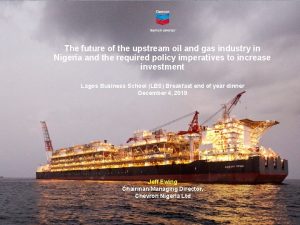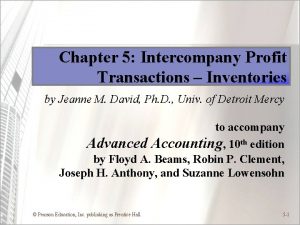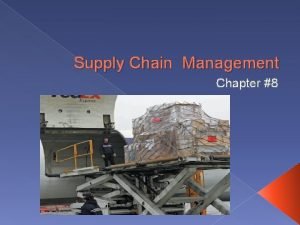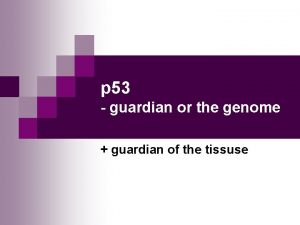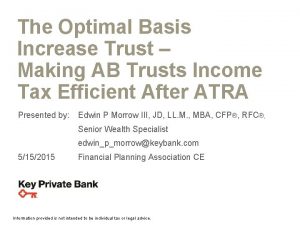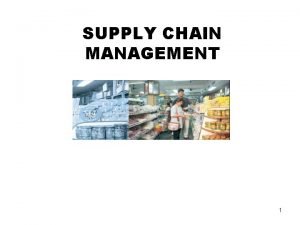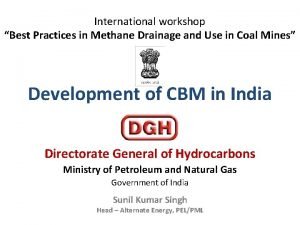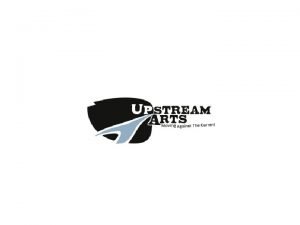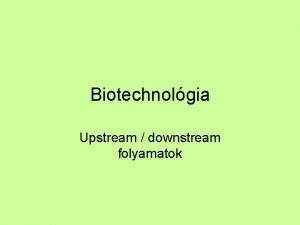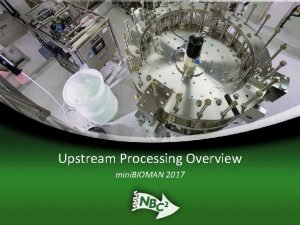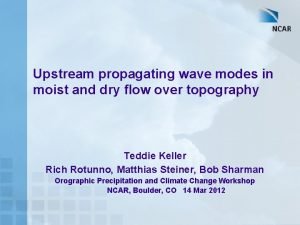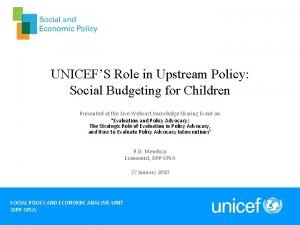The Future of the Upstream The Future of











- Slides: 11

The Future of the Upstream The Future of the Oil and Gas Industry The future of the upstream oil and in gas industry in Nigeria and the. Oil required Upstream and to increase Nigeria and the required policy imperatives Policy Imperatives to investment Gas Industry in Increase Investment Nigeria and the required Policy Imperatives to Increase Investment Lagos Business School (LBS) Breakfast end of year dinner December 4, 2019 • Lagos. Business. School(LBS)Breakfast. Endofofyear. Dinner • Oriental Hotel, Oriental Lekki. Hotel, Lagos, Lekki Nigeria Lagos, Nigeria • December 4, 2019 Jeff Ewing • Jeff Ewing Director, • Chairman/Managing Director, • Chevron Nigeria Chevron Ltd Nigeria Ltd. Chevron Nigeria Ltd © 2019 Chevron Nigeria

Nigeria’s has the resources to compete in the global market world’s 11 th largest oil reserves and 9 th largest gas reserves Country 2014 Year-End Proven Production Oil Reserves Billion rank barrels Venezuela 298 Saudi Arabia 267 Canada 173 Country 11 Iran 2 Russia 4 Iran 158 7 Iraq 150 8 2014 Year-End Proven Production rank Gas Reserves Tcm 34 33 25 Qatar 17 Turkmenistan 10 US Russia 103 4 ▪ Much of Nigeria’s discovered gas can only be delivered to market with higher prices and better infrastructure ▪ Experts believe there is much more to find 1 but incentive for finding gas is limited ▪ Nigeria has enough discovered gas to support both domestic and export supply 2 3 11 1 3 8 Saudi Arabia Kuwait 102 9 UAE 98 6 US 48 1 Libya 48 29 Nigeria 37 12 8 UAE 6 14 Venezuela 6 27 Nigeria 5 22 Algeria 5 9 1 NNPC (2014) estimates Nigeria's total discovered and yet-to-find reserves amount to ~600 tcf SOURCE: BP Statistical Review of World Energy 2015 © 2019 Chevron Nigeria 2

oil & gas industry contributions to Nigeria $425 bn 1 total amount contributed to the Nigeran Government from Oil & Gas revenues (2007 -2018) … and various 600, 000 direct and indirect jobs for the Nigerian economy generated by the Oil & Gas industry (2007 -2018) CSR 3. 0 Mn boe/d of Nigerian Oil & Gas production in 2019 Initiatives: ▪ ▪ ▪ >50, 000 scholarships Hundreds of km of roads Schools and hospitals Skills acquisition / Entrepreneurship Technical capacity building Etc. SOURCE: OPTS analysis, Rystad © 2019 Chevron Nigeria 3

challenges that could limit Nigeria’s ability to attract new investment and successfully take advantage of its reserves Key Challenges Description ▪ – – Challenging 1 business environment Worsening 2 fiscal environment © 2019 Chevron Nigeria Petroleum industry in Nigeria faces several challenges such as security/ community risks ineffective/inefficient regulations lengthy contract approval cycles, and increased macro-economic risks (inflation, currency) ▪ Furthermore, industry faces significant legislative uncertainty as well as bureaucracy and over-regulation by multiple agencies ▪ In addition to petroleum profits tax, company income tax, and royalties, industry pays a plethora of other taxes, fees and levies; leading to substantial additional financial burden – These include but are not limited to: the Education Tax, NDDC Levy, NCDF levy, NPA charges/dues/levies 4

FGN receives ~91% of total JV proceeds after cost JV proceeds at oil price of $50/Bbl and gas price of $2/MMBTU Royalties, levies, taxes & funds FGN receives ~91% of total JV proceeds after cost ▪ Royalty based on shore type / water depth: ▪ Oil 18. 5 – 20% ▪ Gas 5 -7% ▪ Oil 85% and Gas 30% PPT on assessable profit Gas related cost can be deducted from Oil taxable income (AGFA) As investment incentive 5 -15% of tangible capex can be used as a tax deductible (depends on shore type) 2% Education tax Additional levies and fees include: ▪ 3% of cost NDDC ▪ 1% of contracted cost NC Levy Royalties IOC profit $2. 9/boe Total FGN revenue ~$29/bbl 1 ▪ NNPC profit $2. 9 $4. 0 ▪ $16. 9 Taxes 2 Taxes ▪ ▪ Royalties $8. 3 § § § Employee Cost Contract Labor Logistics Cost Materials & Supplies Others Capital Projects: § D&C § FE & MCP § Others IOC share of JV Opex 3 IOC share of JV Capex 3 $3. 2 $7. 2 $4. 0 $4. 8 NNPC share of JV Opex 3 $5. 9 NNPC share of JV Capex 3 ▪ JV split As shareholder NNPC (55% in SPDC, 60% in all other JVs) is obligated to fund its share of investment and operational costs and receive its share of liftings All royalties, levies and taxes are interrelated and have a cumulative influence on the total profit of IOCs and Federal Government of Nigeria 1 Includes royalties, taxes and NNPC profit oil; NOTE: Individuals components may not match totals due to rounding effects 2 Includes VAT and duties 3 Assuming JV split of 40% IOCs and 60% NNPC; excluding VAT and duties SOURCE: OPTS IOC business plan data; Press search © 2019 Chevron

post-PSC amendment: fiscal structure allows government receive 75 -80% of net revenues through royalties, taxes and profit oil Fiscal structure of a PSC proceeds at USD 50/bbl Royalty Oil ▪ ▪ 10% flat for water depth >200 m Price based royalties of 0 -10% depending on the oil price Cost Oil ▪ ▪ Allocated to the contractor Allows for recovery of costs of exploration and development of the field ▪ 50% PPT on assessable profit - as investment incentive 50% of tangible capex can be used as a tax credit (part of disputed items) Additional levies and fees include: 2 % Education tax, 3% of cost NDDC, 1% of contracted cost NC Levy FGN receives 75 -80% of total PSC proceeds IOC Profit oil NNPC Profit oil $ 7. 6 $ 8. 4 Tax oil $ 15. 0 Cost oil $12. 6 Royalty oil 12. 5% $6. 2 Tax Oil ▪ ▪ Profit Oil NNPC entitlement share increases with cumulative production of asset; ranging from 20% to 60%, remainder is for IOCs All royalties, levies and taxes are interrelated and have a cumulative influence on the total profit of IOCs and FGN SOURCE: Industry modeling © 2019 Chevron NOTE: Individuals components may not match totals due to rounding effects 1 Cash flows under current terms for all existing projects (equal bases); undiscounted cash flows; 2020 end of life 2 Costs include both capital and operating expenses, which is not part of either FGN take or Industry profit 3 VAT & Duties are deducted from costs and included in Taxes 6

Nigeria has received only 3% ($2 bn) of the $73 bn major project investments in Africa from 2015 -2019 African major O&G projects FID-ed in 2015 or later Gas Country Total fields Deepwater fields Other fields Egypt 4 4 0 Mozambique 2 0 2 Algeria 3 0 3 Ghana 2 2 0 Senegal / Mauritania 1 0 1 Nigeria 2 0 2 Angola 1 1 0 Chad 1 0 1 Equatorial Guinea 1 0 1 TOTAL AFRICA 17 7 10 SOURCE: Wood Mackenzie Global Economic Model, Press Search © 2019 Chevron Nigeria Oil/gas Total capex of these projects USD bn 28. 2 24. 2 6. 6 5. 2 Factors driving low investment in Nigeria: 4. 3 1) Overall high cost structure 2. 2 2) High government take 1. 2 3) Low rank in ease of doing business 0. 8 0. 3 73. 0 7

PSC Amendment Bill is likely to result in at least 27% less production by 2023 due to drop in competitiveness Oil price of $50/bbl PSC Liquid production – IOC 2019 Business Plans, kbbl/d Production viable under Current Fiscal Terms Production without any further FIDs New PSC Bill (3 rd Reading) The new PSC Amendment translates to: 900 800 700 - 27% oil production decline by 2023 -27% 600 - Loss of ~USD 55. 5 bn of investment compared to Nigeria’s full potential 500 400 The legislative uncertainty around PIB could potentially stall any new projects/production which appear economically viable under the PSC Amendment bill 300 200 - Total lost potential FGN revenue of 10. 4 bn by 2030 100 0 2015 16 17 SOURCE: IOC business plans 2019 © 2019 Chevron Nigeria 18 19 20 21 22 23 24 2025 8 8 8

policy imperatives to increase investment in Nigeria We believe that a holistic industry reform bill can increase competitiveness, unlock new production and benefit both government and industry A well-thought out holistic industry reform bill could “grow the pie” by: ▪ Timely conclusion of ongoing industry reform to guarantee legislative clarity and certainty ▪ Agree on a set of fiscal terms that return revenue to FGN but also safeguard Nigeria’s investment competitiveness and attractiveness ▪ Enabling a conducive business environment, through: – Ensuring safety of lives, security of assets and facilities – Improving the efficiency and effectiveness of institutions responsible for contract approval process Government has indicated that an industry reform discussion and bill could begin in early 2020 © 2019 Chevron Nigeria 9

Thank you © 2019 Chevron Nigeria 10

Uncompetitive fiscal & business environment have pushed Nigeria’s onshore production cost to the last quartile among the top 20 producers O&G Cost curve (capex + opex + government take)1 for top 20 conventional onshore producers 2 USD/boe, 2017 real terms Govt take/boe Opex/boe Capex/boe 50 48 45 43 40 30 31 Iran 22 30 China Argentina 15 20 Saudi Arabia 20 20 Russia 25 29 30 UAE 28 30 Indonesia Venezuela 35 32 32 33 34 36 39 23 16 12 10 Nigeria Kuwait US Oman Canada Algeria Kazakhstan Iraq Turkmenistan Egypt 0 Uzbekistan Libya 5 2030 O&G production MMboe 1 Includes technical cost (capex, opex, and government take; 2030 cash cost for existing fields and full life cycle cost for greenfield project developments 2 production ranking on the basis of 2017 production rate SOURCE: Wood Mackenzie GEM; Mckinsey Analysis © 2019 Chevron Nigeria 11 11
 Future of upstream processing
Future of upstream processing Future perfect time
Future perfect time Future continuous and future perfect
Future continuous and future perfect Upstream vs downstream intercompany sales
Upstream vs downstream intercompany sales Order promising module of supply chain management
Order promising module of supply chain management Downstream e upstream
Downstream e upstream Distribution channel system
Distribution channel system Clayton qtip
Clayton qtip Upstream vk
Upstream vk Replenishment cycle in supply chain
Replenishment cycle in supply chain Well production
Well production Like rowing upstream to stop advancing is to be driven back
Like rowing upstream to stop advancing is to be driven back
